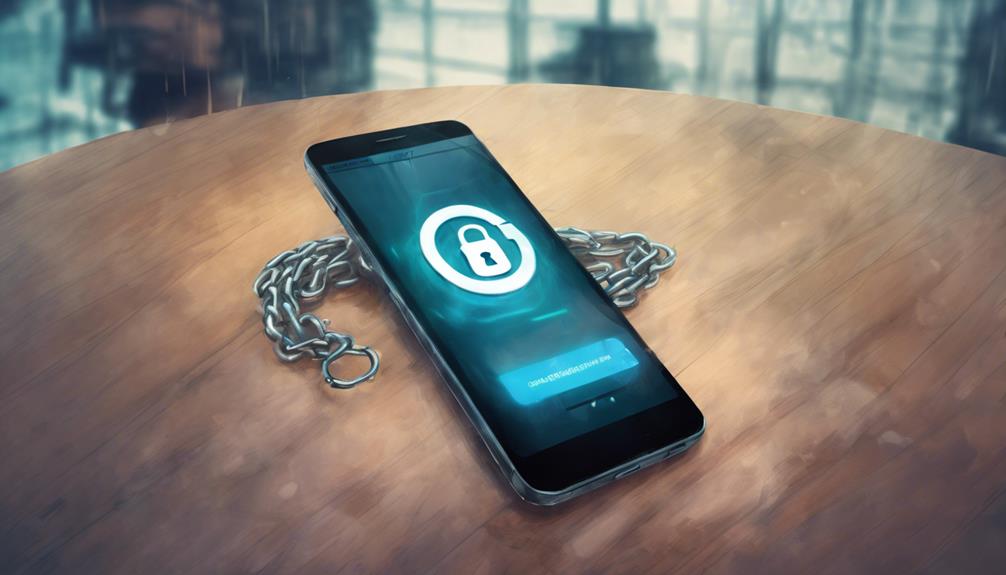Telegram implements end-to-end encryption and the MTProto protocol, enhancing data security against potential hacker breaches. While vulnerabilities exist, especially in data breach incidents, the platform prioritizes user privacy. Encouraging two-factor authentication and unique passwords fortifies account security. Incorporating measures like VPNs and regular session monitoring further bolster defense mechanisms. The app's Secret Chats feature provides additional protection, offering self-destruct timers and anti-screenshot functionalities. Limiting shared information and updating privacy settings regularly optimize confidentiality. By prioritizing robust encryption and user-focused security practices, Telegram remains a reliable choice for privacy-conscious individuals seeking secure communication channels.
Key Takeaways
- End-to-end encryption protects chats.
- Two-factor authentication enhances security.
- Regularly monitor active sessions.
- Avoid third-party apps and bots.
- Utilize VPN for added protection.
Telegram Encryption and Security Features
Telegram's robust encryption and security features guarantee user data remains protected during communication on the platform. With end-to-end encryption implemented for secret chats, Telegram assures that messages are securely transmitted and can only be accessed by the intended recipients. The utilization of the MTProto protocol adds an extra layer of security, making Telegram a reliable and secure messaging app for users concerned about their privacy.
To enhance security measures further, Telegram does not retain encryption keys for secret chats, ensuring that even the platform itself cannot access the content of these messages. Additionally, secret chats are not stored on Telegram's servers, providing users with peace of mind regarding the confidentiality of their conversations.
Risks of Data Breaches on Telegram

Given the evolving landscape of cybersecurity threats, it is imperative to acknowledge the potential risks associated with data breaches on the Telegram platform. Telegram, despite its encryption features, has faced data breaches in the past.
The founder, Pavel Durov, has openly recognized the susceptibility of the platform to cyber attacks, emphasizing the vulnerability of user data stored on Telegram's servers. Storing personal data on Telegram poses risks such as exposing sensitive information to hackers and cyber threats.
In the event of a data breach, users' IP addresses, usernames, phone numbers, contacts, and device details could be compromised. The looming threat of cyber attacks targeting Telegram's servers underscores the critical need for robust security measures to protect user information from malicious actors.
It is essential for Telegram to continuously enhance its security protocols and remain vigilant against potential data breaches to safeguard user data effectively.
Hacker Attacks on Telegram Accounts

Reports indicate a rise in hacker attacks on Telegram accounts, prompting concerns over the security of user data. Common tactics employed by hackers include phishing scams and malware designed to obtain unauthorized access.
To safeguard against such threats, users are advised to enable two-factor authentication and use strong, unique passwords.
Account Security Measures
Implementing robust account security measures is essential to safeguarding your Telegram account from potential hacker attacks. To enhance the privacy and security of your Telegram account, it is recommended to enable two-factor authentication, a feature that adds an extra layer of protection by requiring a second form of verification beyond your password.
Regularly updating your Telegram password and refraining from using easily guessable passwords are also important steps to prevent unauthorized access to your account. Additionally, staying vigilant against phishing attempts and refraining from clicking on suspicious links can help prevent hacker attacks aimed at compromising your account security.
Monitoring your account activity for any unusual login attempts or signs of unauthorized access is critical in detecting and responding to potential threats promptly. By avoiding sharing sensitive information or personal details in chats, you can further minimize the risk of hackers gaining access to your Telegram account.
Common Hacker Tactics
Various tactics employed by hackers pose significant threats to the security of Telegram accounts. These tactics include phishing attacks, exploitation of software vulnerabilities, social engineering techniques, brute force attacks, and the use of unauthorized third-party applications.
Phishing attacks are a prevalent method used to compromise user privacy on Telegram. Hackers create deceptive login pages or messages to steal account credentials.
Exploiting vulnerabilities in the Telegram app or operating system is another strategy employed by malicious actors to gain unauthorized access and potentially breach security measures.
Social engineering techniques, such as impersonation or manipulation, play on users' trust and can lead to the disclosure of sensitive information to hackers.
Brute force attacks involve automated tools trying various password combinations to infiltrate Telegram accounts.
The use of unauthorized third-party apps or bots on Telegram may introduce security concerns, potentially leading to unauthorized data access or the spread of malware within the platform.
Two-Factor Authentication
How can two-factor authentication enhance the security of Telegram accounts against hacker attacks?
Two-factor authentication serves as an important security measure by requiring users to go through an additional verification step beyond entering their password. This additional layer of protection greatly reduces the risk of unauthorized access to Telegram accounts by malicious actors.
Hackers often employ tactics such as phishing scams or brute force attacks to compromise accounts, making two-factor authentication essential in thwarting their efforts. By enabling this feature, users typically receive a code on their phone or email that they must input during the login process, deterring hackers from gaining entry.
Ultimately, setting up two-factor authentication on Telegram is an effective way for individuals to bolster the security of their accounts and minimize the chances of falling victim to cyber threats that could lead to compromised accounts.
Ways to Enhance Telegram Security

To enhance the security of your Telegram account, consider utilizing features such as end-to-end encryption in Secret Chats, enabling two-step verification for added protection, and regularly monitoring active sessions to prevent unauthorized access.
Additionally, incorporating a VPN to conceal your IP address and exercising caution with third-party apps and bots can further bolster the security of your account. These measures provide layers of defense against potential security threats and help safeguard your privacy while using Telegram.
Account Verification Methods
Implementing robust account verification methods is essential to enhance the security of your Telegram account. To protect your account, enable two-factor authentication and verify it with a strong password to prevent unauthorized access by hackers.
Additionally, utilize biometric authentication methods such as fingerprint or face recognition for secure account verification. Regularly review your active sessions and devices to make sure there is no unauthorized access to your account.
It is vital to avoid sharing your verification code or personal information with unknown sources to safeguard your account from hacking attempts. By following these practices, you can greatly increase the security of your Telegram account and reduce the risk of unauthorized access or data breaches.
End-to-End Encryption
Improving Telegram security through end-to-end encryption is crucial in safeguarding sensitive conversations and preventing unauthorized access to messages.
Telegram offers end-to-end encryption in its Secret Chats feature, providing users with a secure messaging platform where conversations are end-to-end encrypted, enhancing Telegram security against potential hackers.
By utilizing two-step verification, users can add an extra layer of protection to prevent unauthorized access to their accounts.
Secret Chats on Telegram offer a higher level of encryption, ensuring that sensitive conversations remain confidential.
Additionally, the option of self-destructing messages in Secret Chats further enhances security by automatically deleting messages after a specified period, reducing the risk of data breaches.
Regularly deleting messages and implementing passcode locks can also help users safeguard their chats from hackers, contributing to a more secure messaging experience on Telegram.
Two-Factor Authentication
Enhancing Telegram security can be effectively achieved through the implementation of two-factor authentication, providing users with an additional security layer that prevents unauthorized access to their accounts.
This feature is important as it acts as a safeguard even if a user's password is compromised, reducing the risk of hackers gaining entry into the Telegram account and potentially accessing sensitive messages and personal information.
Setting up two-factor authentication in the Telegram app settings is a straightforward process, offering users enhanced security to protect against hacking attempts.
It is highly recommended to enable two-factor authentication as a proactive measure to strengthen the security of your Telegram account and ensure that your communications remain private and secure from unauthorized individuals.
Importance of Two-Factor Authentication

Two-factor authentication greatly enhances the security of Telegram accounts by requiring a verification code in addition to a password. This essential security measure serves as a barrier against unauthorized access attempts to your Telegram account.
Here are four important points highlighting the importance of two-factor authentication:
- Protection Against Compromised Passwords: In 2021, 80% of hacking-related breaches involved compromised passwords, underscoring the critical role of two-factor authentication in providing an additional layer of security.
- Prevention of Unauthorized Access: Enabling two-factor authentication on Telegram can prevent unauthorized access to your account, even if malicious actors manage to obtain your password through various means.
- Defense Against Phishing Attacks: Two-factor authentication is an effective defense mechanism against phishing attacks, safeguarding your account from falling victim to deceptive schemes aimed at stealing your login credentials.
- Mitigation of Unauthorized Login Attempts: By requiring additional verification beyond just the password, two-factor authentication significantly reduces the risk of unauthorized login attempts and potential breaches of your sensitive information.
Securing Chats With Secret Chats Feature

In addition, utilizing Telegram's Secret Chats feature provides a robust layer of security for safeguarding confidential conversations from potential threats. This feature employs end-to-end encryption, ensuring that messages remain secure from unauthorized access.
Unlike regular chats, Secret Chats on Telegram do not store messages on servers, further enhancing privacy by preventing data breaches. Users can also set self-destruct timers for messages within Secret Chats, adding an additional level of security against hackers attempting to access sensitive information.
Additionally, Secret Chats in Telegram offer the capability to prevent screenshots, forwarding, and saving of messages, ensuring that conversations are protected from prying eyes. By utilizing Secret Chats, users can securely exchange messages while minimizing the risk of unauthorized access or data leaks, ultimately safeguarding the confidentiality of their communications.
Limiting Information Shared on Telegram

To further bolster security measures on Telegram, users can effectively protect their privacy by limiting the amount of information shared on the platform. By following specific strategies, individuals can enhance their Telegram app security and safeguard their personal data. Here are four key steps to take into account:
- Hide your phone number: Adjust your privacy settings to conceal your phone number from other users, reducing the risk of it falling into the wrong hands.
- Utilize Auto-Delete messages: Take advantage of the feature that automatically removes sensitive messages after a set time, ensuring that no compromising information lingers on the platform.
- Avoid sharing personal information: Refrain from disclosing details like your full name, address, or financial data to minimize the risk of privacy breaches.
- Regularly update privacy settings: Stay vigilant by reviewing and updating your privacy settings consistently, providing an essential layer of defense against potential hackers.
Frequently Asked Questions
Is There a Risk Using Telegram?
There is a risk associated with using Telegram due to potential vulnerabilities that could expose user data to hackers. Despite encryption and security measures, caution should be exercised when sharing personal information on the platform.
What Can Hackers Do on Telegram?
In the bustling virtual metropolis of Telegram, hackers lurk as digital pickpockets, aiming to pilfer personal data, intercept insecure communications, execute phishing schemes, exploit third-party vulnerabilities, and compromise accounts for malware dissemination or data theft.
What Are the Disadvantages of Telegram?
Telegram's disadvantages include potential risks of data breaches due to stored user information. Despite security measures, there is a concern about hackers gaining unauthorized access to accounts. Users should remain vigilant about safeguarding their personal data.
Is Telegram Safer Than Whatsapp?
Telegram is considered safer than WhatsApp due to its end-to-end encryption, lack of automatic cloud backups, and features like key verification. The platform's focus on user privacy and independence from major corporations further solidifies its reputation as a secure messaging option.
Conclusion
To sum up, Telegram provides a variety of encryption and security features to safeguard user data from hackers. Nevertheless, there are still potential risks of data breaches and hacker attacks targeting Telegram accounts.
By incorporating two-factor authentication, making use of the Secret Chats feature, and controlling the information shared on the platform, users can strengthen their security on Telegram.
It is crucial to take a proactive approach in protecting personal information and communications on this messaging platform.









